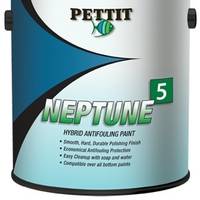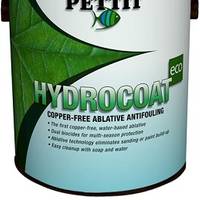Pettit Launched Water-based Antifouling Paint

Pettit Marine Paint, manufacturer of high performance marine coatings, announced today the release of an entry-level water-based antifouling paint, Neptune 5. This latest addition to Pettit’s line of ecofriendly bottom paints provides lower applied cost per square foot, easier application and is priced for budget conscious consumers, the company said. Pettit said it has created a hybrid paint film strong enough to handle the tough marine environment, yet it self-polishes similar to a seasonal ablative.
ClassNK Approves New Super-Efficient Fillet Welding Consumable
Noboru Ueda, Chairman and President of ClassNK announced that it has granted type approval for the new MX-200F welding consumable, developed by Kobe Steel Co., Ltd. (KOBELCO) to greatly improve welding efficiency and coating quality in commercial vessels. Up until now, shipbuilders using conventional fillet welding consumables had to make two welding passes for the required weld leg lengths of around 8mm or above. As the IACS Common Structural Rules (CSR) require the use of 8mm leg lengths in some structural members, this has meant that the relevant welding time for oil tanker and bulk carrier newbuildings has virtually doubled. The IMO Performance Standard for Protective Coatings (PSPC)…
ClassNK Approves Fillet Welding Consumable
Classification society ClassNK announced that it has granted type approval for the new MX-200F welding consumable, developed by Kobe Steel Co., Ltd. (KOBELCO) to improve welding efficiency and coating quality in commercial vessels. Until now, shipbuilders using conventional fillet welding consumables had to make two welding passes for the required weld leg lengths of around 8mm or above. As the IACS Common Structural Rules (CSR) require the use of 8mm leg lengths in some structural members, this has meant that the relevant welding time for oil tanker and bulk carrier newbuildings has virtually doubled. The IMO Performance Standard for Protective Coatings (PSPC)…
New Coating from Petit: Hydrocoat Eco

The Hydrocoat name has been synonymous with waterborne, marine ablative technology for almost 20 years. First came Pettit’s award winning Hydrocoat, a multi-season, ablative antifouling paint, which the manufacturer claims was the benchmark for clean, highly effective and easy to use antifoulings. Last year the Hydrocoat line was expanded when the, Hydrocoat SR, reportedly the world’s first and only dual-biocide, water-based, multi-season ablative bottom paint, was introduced to the market. Now, Pettit launched the latest product in the Hydrocoat line up, Hydrocoat Eco.
MOL Adopts Low-friction Hull Paint
Mitsui O.S.K. Lines, Ltd. has adopted a new low-friction “Seaflo Neo” developed by Chugoku Marine Paint, Ltd. After analyzing the results of an onboard test with a newbuilding vessel, the company confirmed that the new paint offers improvements in fuel efficiency compared to conventional paints. This will contribute to the reduction of CO2 emissions from vessels. Friction between the hull and the water accounts for the majority of resistance as a vessel moves through the water. Reducing friction drag is a very effective way to reduce CO2 emissions during vessel operation. MOL has taken a proactive stance in developing and adopting a low-friction paint as one of its environmental initiatives.
New Coatings Technology for Chemical Tankers

International Paint has introduced Interline9001, a new Bimodal Epoxy coating for the cargo tanks of chemical tankers. With enhanced cargo resistance, zero absorption for many cargoes and fewer cycling restrictions, Interline9001 simplifies the carriage of a wide range of liquid cargoes, optimizing vessel earning potential. Modern chemical tankers of IMO Ship type I, II and III are designed and equipped to handle a very wide range of liquid cargoes ranging from relatively innocuous materials such as vegetable oils to more aggressive types such as ethylene dichloride and caustic soda.
New coatings safer, last longer Bottom Line: It's Not Just A Paint Job
On the surface, the subject of paint seems simple. After all, it's just a paint job, right? For maritime applications, however, beauty is much more than skin deep. The coating of surfaces on ships is a complex combination of materials, chemicals and preparation to combat corrosion and maintain a sharp appearance. The coatings must wear well in the worst of weather and withstand the most extreme environments. They must last with little maintenance, must be earth friendly and safe for people and other living things, and last but certainly not least, they must be affordable. The paint job found on a contemporary ship may look the same as that of a ship of several decades ago, when in fact very little is the same.





